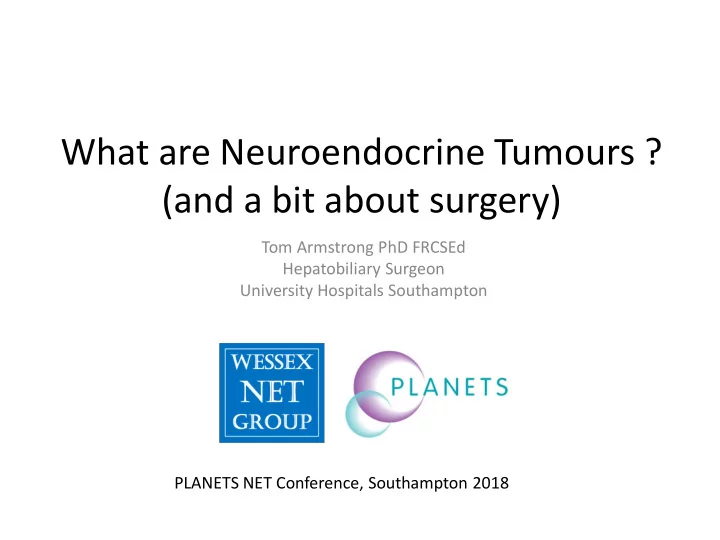

What are Neuroendocrine Tumours ? (and a bit about surgery) Tom Armstrong PhD FRCSEd Hepatobiliary Surgeon University Hospitals Southampton PLANETS NET Conference, Southampton 2018
What is the Wessex NET Group? Basingstoke Salisbury Winchester UHS RBH QAH Chichester Poole • weekly MDT • monthly MDT • joint clinic videolink • joint clinic • joint clinic Dorchester IoW Channel Islands
What is the Wessex NET Group?
What is the Wessex NET Group? …. a partnership that has led to the recognition of the Wessex NET Group European Centre of Excellence
Nervism 1883 Ivan Pavlov • recognised that dogs salivate when given food • realised the dogs salivate when they think that they were going to be given food First realisation that nervous system (brain) plays a dominant role in bodily functions
More to it than just nervism: there is endocrinism too! • What does endocrine mean?
More to it than just nervism: there is endocrinism too! • What does endocrine mean? • Refers to a gland which secretes hormones directly into blood stream
More to it than just nervism: there is endocrinism too! • Hormone=chemical messenger sent from one cell to another in blood stream
Endocrine system in humans
How do nerves and endocrine system interact? • 1867 Islands of cells in pancreas – Langerhans • 1870 Glands within the intestines (EC cells) – Heidenhain • 1902 Realisation that hormones regulated gut function – Bayliss and Starling • 1938 EC cells made gut hormones and that these interacted with neurones – Feyter
Neuroendocrine System in action • Paradigm shift in understanding Hormone: travels in blood stream
Anatomy and Function of Gastrointestinal Tract
Neuroendocrine Pancreatic Function • Systemic Hormones – Insulin: drives sugars into cells – Glucagon: releases sugars from liver • Gut Hormones – Gastrin: production of acid in stomach – VIP: encourages GI secretions – Somatostatin: suppresses release of other hormones – PPP: reduces apetite and slows release of digestive juices
Neuroendocrine Pancreatic Function Feedback Mechanisms
Neuroendocrine Gut Function • Gut Hormones – Serotonin: gut function – (mood, sleep, healing) – Bradykinin: gut contraction/motility – (dilate blood vessels, causes low blood pressure) – Histamine: immune function – (too much causes wheezing and swelling)
Why do tumours form? • Environmental Factors – Smoking, alcohol • Chronic Inflammation – Inflammatory bowel disease • Genetic Factors – MEN syndromes Normal Feedback Mechanisms Fail
Why do tumours cause disease? • Block anatomical tracts (pipes) – eg jaundice, vomiting, pain • Stop normal function of organs – eg liver • Secrete excessive hormones – eg insulin, thyroxin – syndrome
NETS • 1890 Case report in Lancet • Woman in 50’s • Egg sized lumps in intestine • Diarrhoea • Flushing after eating • 1907 Carcinoma like (Carcinoid) • Oberndorfer
NETS: anatomic distribution
Functioning vs. Non-Functioning NETs • Functioning – Hormonally active, cause syndromes which lead to investigation • Non-functioning – Usually found incidentally or at a more advanced stage
Presentation of Non-Functioning NETs • Chance • Jaundice • Bowel Obstruction • Cough • Irritable bowel • Anaemia
Presentation of functioning NETs: Insulinoma Low Blood Sugar Stress Response • headache • anxiety • lethargy • tremor • dizzyness • nausea • blurred vision • sweating
Insulinoma Insulinoma: failure of negative feedback
Insulinoma Insulinoma: failure of negative feedback
Insulinoma Insulinoma: failure of negative feedback
Insulinoma Insulinoma: failure of negative feedback
Insulinoma • Comprise 75% of functioning pancreatic NET • Still rare • Usually present in 50s • 90%<2cm • 10% multiple • 10% malignant: if metastasis • 10% MEN-1
Presentation of functioning NETs: Gastrinoma • Excess stomach acid • Ulceration – Stomach – Duodenum • Pain, weight loss • Doesn’t respond to treatment
Gastrinoma • Zollinger-Ellison Syndrome
Gastrinoma H 2 Blocker e.g. ranitidine Proton Pump Inhibitor e.g. omeprazole Somatostatin Analogues
Presentation of functioning NETs: Carcinoid (midgut NETs) • Diarrhoea • Abdominal pain • Weight loss • Flushing • Heart failure
Presentation of functioning NETs: Carcinoid (midgut NETs) • Diarrhoea • Abdominal pain • Weight loss • Flushing • Heart failure – serotonin
Staging NETs • TNM system – Tumour= size/site of primary tumour • +/- invasion of primary into adjacent organ – Node= spread of primary tumour to lymph nodes • via lymphatic channels – Metastasis= spread of primary tumour to other organs • via blood stream
Staging NETs • Scans – CT – MRI – Octrotide – Gallium PET • Endoscopy – Gastroscopy – Colonoscopy – Capsule – Endoscopic ultrasound
Grading NETs • Need biopsy – Primary • Endoscopy – Secondary/Metastasis • Liver Grade 1 Grade 2 Grade 3 Grade 3 NET NET NET NEC Proliferation <2% 3-19% 20-49% >50% index (Ki67)
Managing NETs Localised Curative Surgery PI <2% Multimodal Treatment • ablation • embolisation Metastatic • PRRT PI 2-20% • surgical debulking • somatostatin analogues PI >20% Systemic Therapy
Understanding Treatment Terminology • Systemic: – a treatment that treats any NET cell in the body • Lanreotide/Octreotide • Chemotherapy • PRRT • Locoregional: – a treatment aimed at one specific area of body or an organ • Surgery • TACE or SIRT • Cytoreductive/Debulking: – surgery to remove bulk of disease • Multimodal: – A combination of treatments
Evolution of NET Treatment Oberg K Endocrinol Metab Clin N Am 2018; 47: 711-31
Wessex NET Group Management Algorithm Cytoreduction Symptom Control
Surgery for NETs
Surgical Procedures: liver
Surgical Procedures: liver
Surgical Procedures: liver
Surgical Procedures: liver
Surgical Procedures: liver
Surgical Procedures: pancreas Enucleation of small PNETs
Surgical Procedures: pancreas Distal pancreatectomy +/- splenectomy
Surgical Procedures: pancreas Pancreaticoduodenectomy (Whipples)
Whipple’s Procedure
Surgical Procedures: bowel
Surgical Procedures: bowel Lymph Node Stage 4 3 2 1 0
Surgical Procedures: bowel
Summary • NETs are slow growing a slow growing type of cancer that form in the GI neuroendocrine system • We do not know what causes them • NETs can be described as functioning or non- functioning depending on whether they produce hormones • There are many effective treatment modalities for NETs
Recommend
More recommend